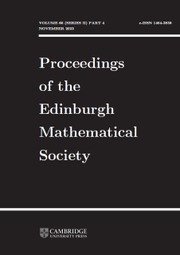No CrossRef data available.
Article contents
Ideals of equations for elements in a free group and Stallings folding
Published online by Cambridge University Press: 19 December 2024
Abstract
Let  $H\le F$ be two finitely generated free groups. Given
$H\le F$ be two finitely generated free groups. Given  $g\in F$, we study the ideal
$g\in F$, we study the ideal  $\mathfrak I_g$ of equations for g with coefficients in H, i.e. the elements
$\mathfrak I_g$ of equations for g with coefficients in H, i.e. the elements  $w(x)\in H*\langle x\rangle$ such that
$w(x)\in H*\langle x\rangle$ such that  $w(g)=1$ in F. The ideal
$w(g)=1$ in F. The ideal  $\mathfrak I_g$ is a normal subgroup of
$\mathfrak I_g$ is a normal subgroup of  $H*\langle x\rangle$, and it’s possible to algorithmically compute a finite normal generating set for
$H*\langle x\rangle$, and it’s possible to algorithmically compute a finite normal generating set for  $\mathfrak I_g$; we give a description of one such algorithm, based on Stallings folding operations. We provide an algorithm to find an equation in w(x)\in
$\mathfrak I_g$; we give a description of one such algorithm, based on Stallings folding operations. We provide an algorithm to find an equation in w(x)\in $\mathfrak I_g$ with minimum degree, i.e. such that its cyclic reduction contains the minimum possible number of occurrences of x and x−1; this answers a question of A. Rosenmann and E. Ventura. More generally, we show how to algorithmically compute the set Dg of all integers d such that
$\mathfrak I_g$ with minimum degree, i.e. such that its cyclic reduction contains the minimum possible number of occurrences of x and x−1; this answers a question of A. Rosenmann and E. Ventura. More generally, we show how to algorithmically compute the set Dg of all integers d such that  $\mathfrak I_g$ contains equations of degree d; we show that Dg coincides, up to a finite set, with either
$\mathfrak I_g$ contains equations of degree d; we show that Dg coincides, up to a finite set, with either  $\mathbb N$ or
$\mathbb N$ or  $2\mathbb N$. Finally, we provide examples to illustrate the techniques introduced in this paper. We discuss the case where
$2\mathbb N$. Finally, we provide examples to illustrate the techniques introduced in this paper. We discuss the case where  ${\text{rank}}(H)=1$. We prove that both kinds of sets Dg can actually occur. We show that the equations of minimum possible degree aren’t in general enough to generate the whole ideal
${\text{rank}}(H)=1$. We prove that both kinds of sets Dg can actually occur. We show that the equations of minimum possible degree aren’t in general enough to generate the whole ideal  $\mathfrak I_g$ as a normal subgroup.
$\mathfrak I_g$ as a normal subgroup.
Keywords
MSC classification
Information
- Type
- Research Article
- Information
- Copyright
- © The Author(s), 2024. Published by Cambridge University Press on Behalf of The Edinburgh Mathematical Society


